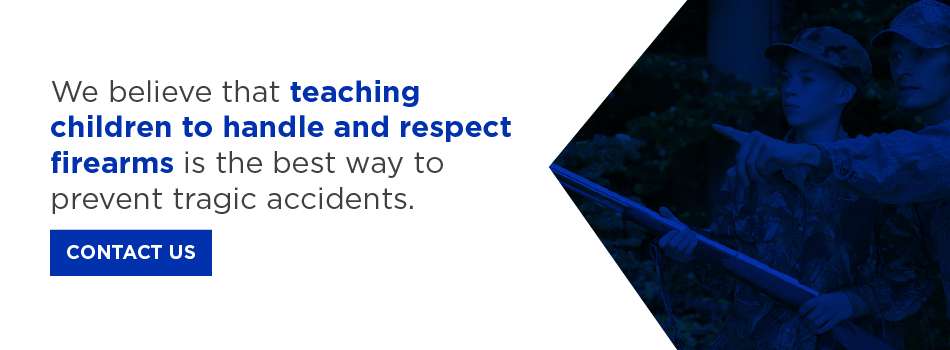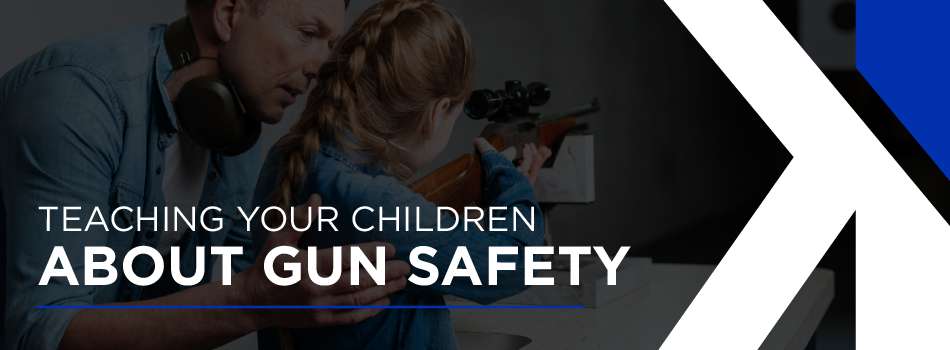
-When to start teaching your children about guns
-How to teach your children about guns
-Gun education options
Guns and gun safety dominate a lot of the national agenda these days, and it’s easy to see why. You can’t turn on the television or read a newspaper without at least one story about someone being injured in a gun-related incident. As a parent — even a gun-owning parent — it’s tempting to want to protect your children from these accidents by simply pretending that guns don’t exist. After all, if you don’t talk about the gun hidden in your closet, your child won’t ever find it, right?
Wrong.
Ignoring guns and neglecting to teach your children to view guns safely and responsibility is a dangerous thing to do. Even if you don’t keep guns in your home, your children are likely to have friends whose parents are gun owners, which means at some point, your child may encounter a gun.
One of the vital things you can do as a parent is to make it a priority to teach your children to handle guns properly. When you demystify guns and teach children the appropriate way to handle them, their risk of accidental injury plummets. In Pennsylvania, hunting-related shooting incidents have decreased by 80% in the 60 years since the state began investing in hunter education courses.
Teaching children about gun safety can be a bit nervewracking as a parent. Knowing the right things to say and do to demonstrate safety doesn’t always come naturally, especially with a topic like firearms and safety.
Wondering where to start when it comes to gun safety for children? We’ve got you covered!
WHEN TO TEACH YOUR CHILDREN ABOUT GUNS
What’s the right age to start teaching your child about guns? The earlier, the better, especially if you have one or more guns in your home. But there’s a difference between teaching your children ABOUT guns and teaching your children HOW to shoot a gun. Teaching children about guns can — and should — begin as soon as your child is old enough to understand what you’re saying. Teaching children how to shoot will come later.
As their parent, you are the best judge of when your child is ready to grasp the concept of guns and learn how to handle them appropriately. But, in general, you can follow these age-appropriate guidelines as you talk to your child and teach them how to handle a gun.
1. Start With Gun Safety

As a general rule of thumb, you should begin teaching children about guns when they first show awareness or interest in them. This might mean your child notices Dad cleaning a hunting rifle or hears someone talking about going to shoot at the range. This will most likely happen between 3 and 7 years of age.
Around this time, you can start teaching children that guns — even toy guns — are not toys. You wouldn’t leave a real gun laying around, so the best way to enforce this rule with your children is to teach them not to leave toy guns laying around either. You can demonstrate safety by purchasing a chest with a lock that your child can use as their own “gun safe” where they store any toy guns, including water guns, when they aren’t in use. While this may seem extreme, it’s actually a great way to demonstrate to your child that guns can be used for sport, but should never be considered a “toy.”
This is also a perfect time to teach your child what to do if they come across a gun — stop, run away and tell a grownup. There are several different methods out there for the best way to teach this to your child, including the NRA’s Eddie Eagle Program, which has some helpful guidelines for young children that many call the “Stop, Drop and Roll” of gun safety.
2. Move on to Gun Maintenance

Once your child is between 5 and 7 years of age, you can introduce them to the parts of a gun and teach them about gun maintenance. This helps to familiarize them with the parts of the gun, as well as proper handling of the gun apart and put together. When you take away the mystery behind a gun, it takes away the temptation a child might otherwise feel to explore it.
As you teach them about the parts of a gun, you can also continue to reinforce safety and the importance of proper use and handling at all times. Just because your child is older doesn’t mean that these concepts are no longer meaningful. Weave reminders about firearm safety throughout discussions about gun maintenance and makeup.
3. Start Small
Between 7 and 10 years of age, if your child is mature enough to do so, you can introduce your child to proper shooting form and the basics of marksmanship. One of the best ways to introduce these concepts is by using a BB gun, pellet gun or Airsoft gun. These are an appropriate option because they have little to no recoil, and you can teach responsible handling without the risks associated with a firearm.
At this point, your future marksman is likely enjoying having a gun in their hands and may even be showing early signs of being a good shot. Encourage their excitement, but temper it with regular reminders that their gun is not a toy, and they should never treat it as one. At this age, you may also need to stress that they may not show their BB gun off to their friends without an adult present, and they certainly should never take it out of the house.
4. The Real Deal
Between 8 and 14 years of age — depending on your child’s maturity and interest level — it will be time to teach them good marksmanship with a real pistol or hunting rifle during a short hunting trip. At this point, reviewing all of the information you’ve presented over the years will be especially important because they have a real firearm in their hands. Everything you’ve said up to this point will come together, and your child will be expected to combine their knowledge of safety, maintenance and skill all at once.
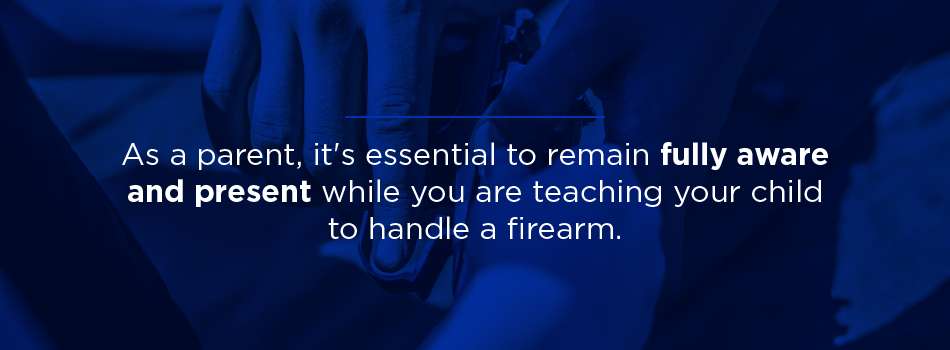
As a parent, it’s essential to remain fully aware and present while you are teaching your child to handle a firearm. Put away your cell phone, turn off the television and resist the urge to get out your own firearm for practice. This isn’t the time or the place. When your child is ready to shoot, shut out the distractions and focus on what you are doing.
5. Honing Their Skills
Some children won’t show an interest in guns past an occasional hunting trip. Others will enjoy sharing a hobby with their parent and want to continue developing their knowledge and skills in the woods or at the range. Once your child reaches their teens, it’s perfectly acceptable to encourage their interest and help them to develop their hobby if you believe they are mature enough to do so.
While it can be a sticky subject, your supervisory role with your child and handguns may continue well into their teens and early adult years. In most states, you must be 18 to purchase firearms, but in some cases, you may decide that, even at 18, your child isn’t mature enough to handle guns without additional supervision.
Why?
There’s no magic age when an individual becomes mature enough to handle weapons alone. A person’s impulse control and maturity typically aren’t fully developed until age 25, which means that even though a person can legally purchase a weapon at 18, they aren’t necessarily mature enough to use good judgment in handling one. As a parent, your role as overseer and protector does not end when your child turns 18. As much as possible, continue to monitor your child’s progress and make sure they maintain safe standards as they grow.
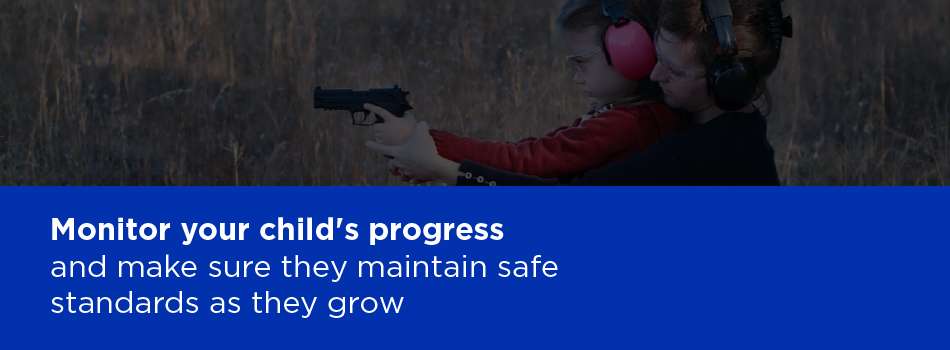
HOW TO TEACH A CHILD ABOUT GUNS
You know your child is old enough to begin talking to them about firearms. But it can be difficult to know how to talk to them. When it comes to teaching your child about guns, only you know how best to get the message across. Every child is different, and you’ll need to factor in their personality as you decide on the best course of action.
However, you can follow some general guidelines to make the most out of your conversation.
1. Take the Mystery out of Firearms
We’ve all heard the news reports about teens who were home alone and found Dad’s gun in the nightstand or children who were going through Mom’s purse and found her personal handgun. These situations are sad, unfortunate incidents, but one thing many of them share is this — the children were intrigued by something they didn’t know much about.
The best way to prevent your child from stumbling across a gun and following their natural urge to explore is to head them off. Let them explore. Show them your unloaded gun. Talk to them about how you use it. Let them watch you take it apart and clean it. If your child has toy guns, you can also start teaching them how to treat guns by treating their toy guns the same way you’d treat real ones. Use their toy gun to teach them how to hold a gun, how to point a gun and begin introducing the basics of gun etiquette and safety, such as never pointing a gun at another person.
When you do this, you satisfy their curiosity over guns in a safe, controlled environment. Then, if they come across one at their friends’ house, the mystery is gone, and they aren’t tempted to touch and play with it. It also diminishes their inclination to try to access their parents’ guns because they know their parents will allow them to handle the guns another time when they are together, so there is no reason to sneak behind their back.
2. Incorporate Visual Aids
Depending on your child’s maturity level, many parents also find it helpful to show children pictures of bloody animals or demonstrate the force of a gunshot by taking their children to the range and showing them what targets look like after a round. These visual aids are a great way to show children exactly what a gun does — and what will happen if they try to shoot it.
The object here is not to terrify your child but to help them understand the purpose and power of a firearm. If you suspect that your child will be emotionally traumatized by photos or is easily terrified by loud noises, then it may be best to hold off on this step until they are more mature.
3. Monkey See, Monkey Do
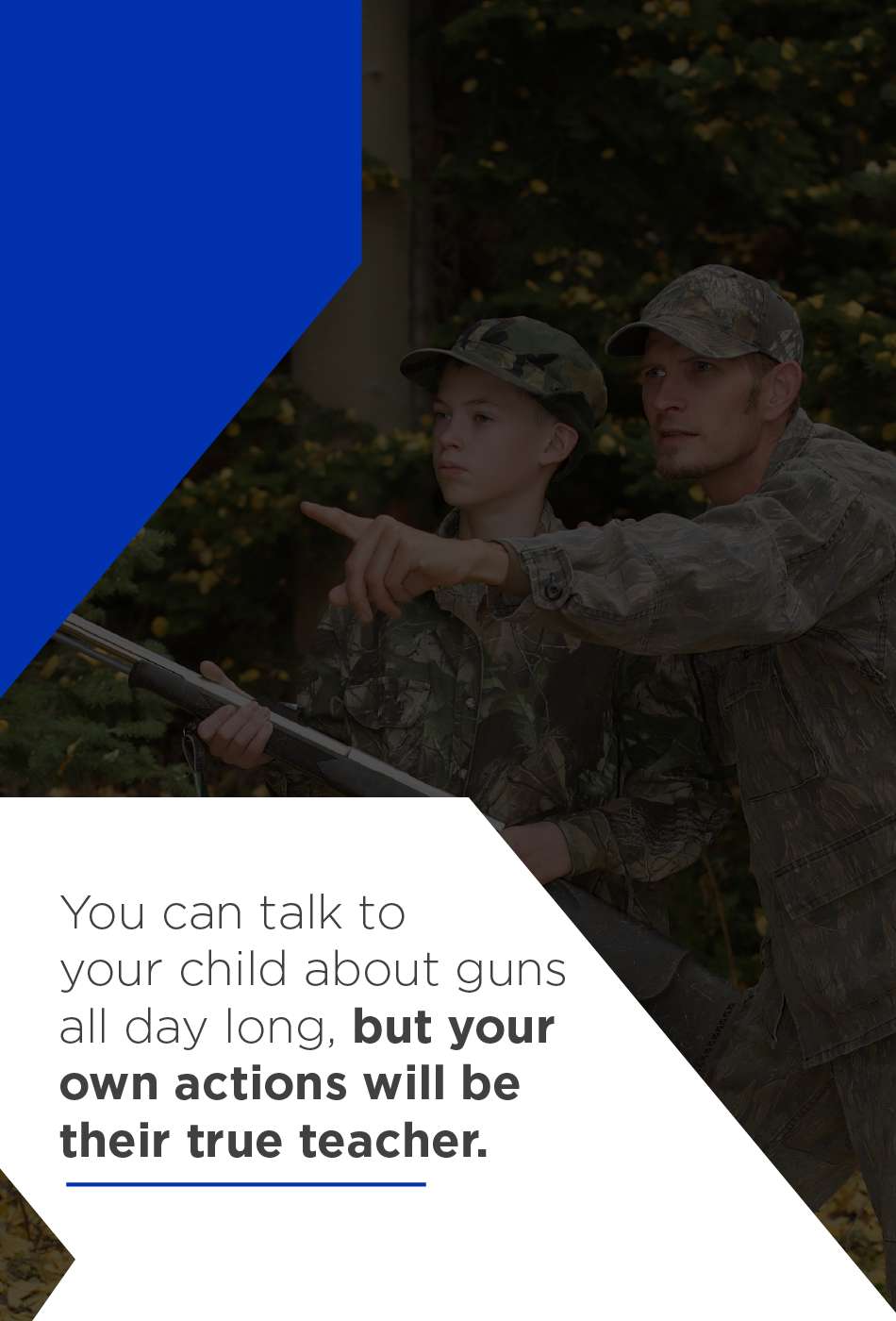
You can talk to your child about guns all day long, but your own actions will be their true teacher. The best way to teach your child how to respect guns and handle them appropriately is to do that yourself. This isn’t the time for an “I know the rules, so I can break them” philosophy. This is the time to follow proper gun safety procedures by keeping them in a safe when you aren’t using them. Clean and maintain your guns properly. Refresh your memory when it comes to rules and etiquette on the range and out in the woods.
4. Don’t Take Your Own Firearm on Your Child’s First Hunt
Many fathers have dreamed of their first father/son hunting trip since their child was in diapers. It can be tempting to take along your own firearm and fulfill your dream of sitting up in a deer stand with your son poised to shoot the first buck that comes across your path. Hold off on fulfilling that dream. The first time you decide your child is ready to join you on a hunting trip, leave your own firearm at home. Even if your child has been practicing with a BB gun or has been handling guns since they were little, the reality of a first hunt can be intense. They’re going to need your full attention and sometimes even physical assistance. It’s easier to give them both of those things if you aren’t also keeping track of your own gun.
5. Emphasize Safety Above All Else
Even as your child progresses in their knowledge and understanding of firearms, it’s critical to continue to stress safety above all else. Remember, a child’s impulse control isn’t fully developed, so it’s easy for them to forget what they’ve learned if they’re focused on showing off or goofing around with their friends.
Above all else, remind your child often that if they encounter an unsecured gun, they should leave and find an adult. This may be challenging to explain to older children who have already handled firearms but continue to drive this point home until you are confident that your child is capable of making a wise choice.
6. Look for Teachable Moments
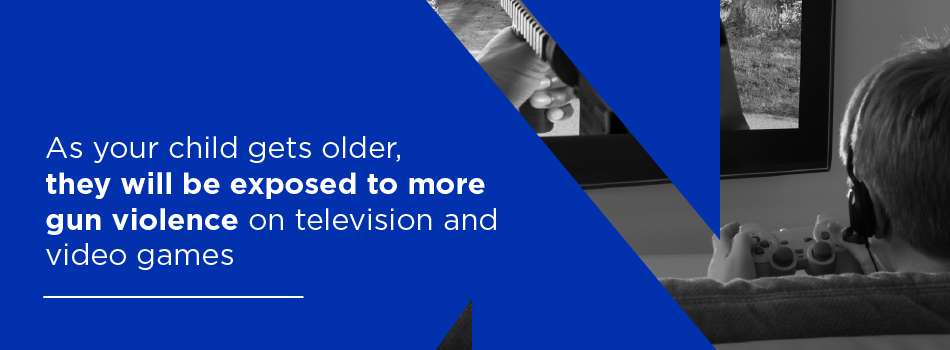
As your child gets older, they will be exposed to more gun violence on television and video games. As an adult, you realize that these games are unrealistic, but a child does not. While it’s a good idea to limit their exposure to these types of movies and entertainment, you can’t always prevent them from seeing something they shouldn’t. Rather than ignore what they’ve seen, take it as an opportunity to discuss how firearms were used or abused and the ways that the movie violated the safety standards you’ve laid out for them.
Stories of gun violence in the news media can also provide a means of discussion for you and your child. While stories of firearm accidents are sad, especially ones where the accident could have been prevented, they offer a significant teaching moment for you and your child. Don’t be afraid to share these stories with your child and then discuss the right way to handle it if they ever find themselves in a similar situation.
GUN EDUCATION FOR CHILDREN
When it comes to firearms, parents are a child’s first and most important instructor. However, as a child develops an interest in firearms and hunting, it’s always useful to have outside help. Enrolling your child in a hunter safety course or a youth rifle course is a great way to hone their skills and continue to teach them to handle a gun safely. And, as every parent knows, children are always more willing to learn from someone who isn’t their parent!
What kinds of classes can your children take?
1. Hunter Safety Course
The state of Pennsylvania requires all first-time hunters to complete Hunter-Trapper Education to obtain a license to hunt. Children as young as 11 years old can enroll in the Hunter-Trapper education class. The state encourages parents to attend the class with their children. Besides being a great refresher course for even the most experienced of hunters, taking the course with your child will open the door to many great conversations about firearm handling and safety.
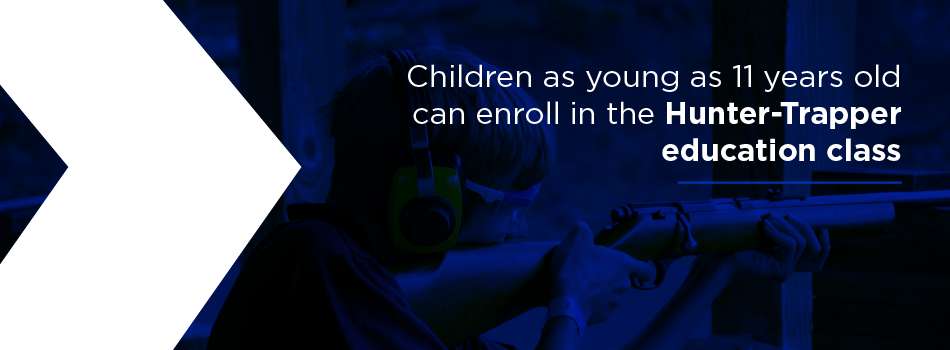
Pennsylvania’s course covers a variety of topics, including safe hunting, survival basics, firearm safety, responsible hunting behaviors and basic shooting. Because it covers so many topics, you shouldn’t rely on it to teach your child everything they need to know, but it’s a good way to bring together many of the topics they’ve learned as they’ve watched you prepare for a hunting trip.
Children under the age of 16 are required to take the hunter safety course in a classroom, which means that your child will be face-to-face with an instructor and other hunters, providing them with a place to ask questions and learn from others too.
2. Youth Rifle Course
Keystone Shooting Center offers a two-hour rifle training course for children 10 to 16 years of age. The purpose of this course is to introduce new shooters to a rifle. At the end of the course, your child will know how to hold, carry and shoot a rifle safely. This course is also designed to discuss and reinforce firearm safety. During the course, children will receive instructional time as well as live fire time on the range. The class is designed to emphasize gun awareness and safety above skill. What does this mean? It means that our goal is to provide a safe, educational environment where your child can satisfy their curiosity about firearms and learn how to handle one safely.
A parent should accompany children to this class. We believe that you can better help your child when you see what they see and hear the instruction they receive. We’re happy to teach your children about firearms, but there’s only so much we can teach them in two hours. As the parent, you must continue the discussion at home and help your child develop their skill and understanding of firearms.
3. Youth Pistol
In addition to the Youth Rifle Course, the Keystone Shooting Center offers a Youth Pistol course. Geared toward children ages 12 and older, this two-hour course is designed to familiarize your child with handguns. The class is divided into two sections. The first section is a “classroom” session that heavily emphasizes safety. The second section of the course is live instruction on the range designed to familiarize your child with this particular type of firearm.
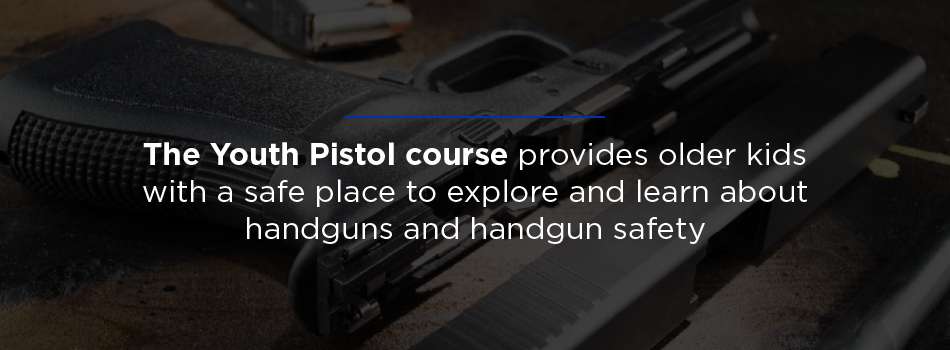
The Youth Pistol course provides older kids with a safe place to explore and learn about handguns and handgun safety. After all, the best way to prevent a gun-related accident is by teaching children how to handle a gun in a safe environment.
While the minimum age to attend this course is 12, we firmly believe that a person’s age is not always an accurate measure of their maturity. As the parent, we encourage you to use good judgment in determining whether your teen or preteen is ready to take this next step in learning about and handling firearms.
GUN EDUCATION FOR ALL AGES
At the Keystone Shooting Center, we believe that teaching children to handle and respect firearms is the best way to prevent tragic accidents. Because of this, we are proud to offer several youth-focused classes that emphasize the safe handling of firearms and their proper uses. Our goal is to support parents as they teach their children to respect firearms and handle them appropriately.
The Keystone Shooting Center is a veteran-owned and operated facility located in Mars, Pa. While we’re proud to offer our youth-centered courses, the Keystone Shooting Center offers high-quality instruction to customers of all ages, including tactical shoot, women-only courses, gun cleaning and holster draw. Our range is open for practice during normal business hours, by walk-in or appointment. We welcome our customers to bring their own firearms for practice, but we do offer rental firearms as well.
To register for a class or get more information, contact us online or by phone at (412) 357-8000.


 Search
Search 
